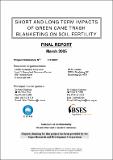| Abstract | In the last three decades, there has been a widespread adoption of green cane harvesting-trash blanketing (GCTB) in the Australian sugarcane industry, generally motivated by the practical advantages (e.g. weed control, easier harvesting in wet times, etc.) associated with the GCTB farming system. While many studies have been conducted on the impact of trash blanketing on issues such as yield, soil erosion and soil physical properties, surprisingly little is known about the fate of nutrients in trash (whether burnt or retained), the decomposition of trash blankets, or impacts of GCTB on soil fertility and hence fertiliser management. This project aimed to provide information on these issues and so determine if canegrowers need to change their nutrient management strategies when they switch from burnt cane harvesting to a GCTB system. Principal findings from this project are: • Burning trash reduces trash dry matter by 70 % (pre-harvest burn) to 95 % (pre- and postharvest burn), and the loss of nutrients when trash is burnt is strongly related to the loss of dry matter. Thus GCTB can substantially increase organic matter and nutrient retention. • Rainfall will quickly leach some nutrients, especially potassium (K), from freshly harvested trash into the soil. • Trash decomposes slower than expected from its biochemical composition, with up to 10% of trash deposited on the soil after harvest still present one year later. However, the decomposition of trash can be accurately predicted across soils types and climates from sugarcane-specific residue decomposition models. • Trash blanketing, for up to 17 years, increases soil organic carbon (C) and nitrogen (N) concentrations in the top 50-100 mm of soil, but has negligible impact on concentrations of other nutrients in the soil. • The presence of trash blankets increases denitrification by 20 % on waterlogged, heavy soils in the period immediately following applications of N fertiliser. Denitrification in this situation could be accurately modelled, and this modelling provided the first test of the denitrification sub-model in The Agricultural Productions Systems Simulator (APSIM). • K from trash is plant-available, so fertiliser and trash K should have similar value as nutrients. However, there was not a significant yield response to K from trash in either pot or field experiments, possibly due to variability in the results. Thus it is not clear that recommendations of K management in trash-blanketed crops should differ from those for burnt crops. • Simulation studies of N dynamics in GCTB systems suggest that: o There may be a negative, short-term impact of trash blanketing on sugarcane yields for at least 5 years after initiating GCTB. This is due to the immobilisation of N by the decomposing trash. During this time it is important that N applications not be reduced below those used when trash was burnt. Following that time; o N fertiliser applications to ratoon crops in GCTB systems should be maintained at rates appropriate for burnt systems, despite N in trash being recycled in the GCTB 2 SUGAR RESEARCH & DEVELOPMENT CORPORATION FINALREPORT - PROJECT NO. CTA022 system. The additional N from trash is immobilised by decomposing trash blankets or lost to the environment. o In plant crops, N fertiliser applications in GCTB systems could be reduced to half that recommended for burnt systems. o Average environmental losses of N, from both denitrification and leaching, are likely to be greater from GCTB systems at all rates of N fertiliser (i.e. less than, equal to or greater than optimal rates) so particular caution should be taken to avoid overapplication of N in GCTB systems. During the project, information was disseminated through the industry in numerous presentations given at field days, shed meetings, Mill Supplier Committee meetings, CRCSugar meetings (at which BSES extension officers were present), ASSCT, etc. In addition, a series of workshops was run in collaboration with CRC-Sugar on the impact of trash blanketing on soil fertility and fertiliser management. The workshops were aimed at BSES, productivity board and fertiliser company advisers, and conducted using a participatory approach to information exchange, based on adult learning principles. 3 |

